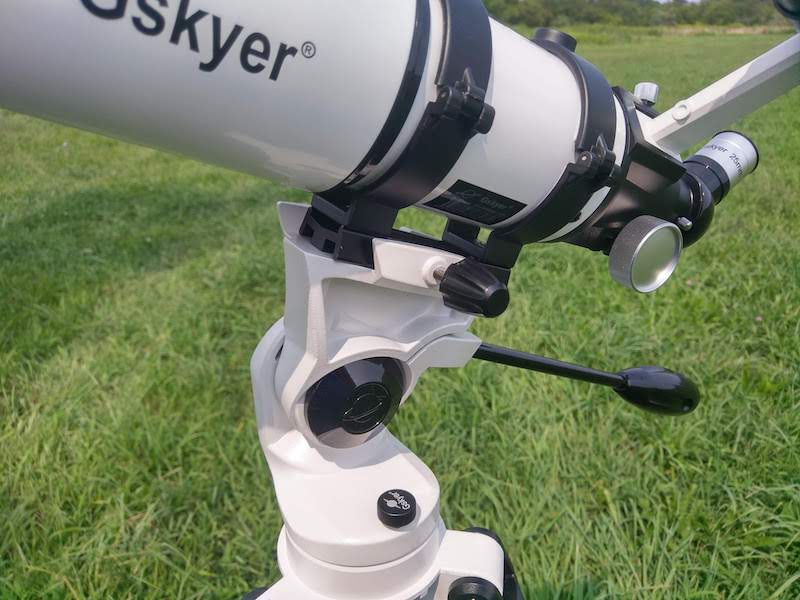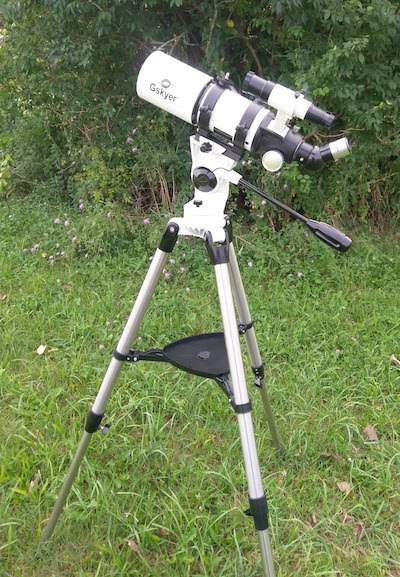Instructions On How To Use
There is a picture card that shows how to put the parts together, but there is no instruction book on how to use the scope. Gskyer apparently assumes you know about telescopes. I will touch on this point throughout the review. For me, an experienced telescope owner, this was not an issue. However, if you are new to telescopes or astronomy, this might be a reason to choose another package. For example, Meade and Celestron typically include instructions on use as well as advice about using the scope, selecting eyepieces, etc.
The Optical Tube Assembly
This is what you might normally think of as a telescope. The OTA is an 80 mm aperture achromatic refractor. That means it has a lens in the front that gathers light and focuses the light into the eyepiece where you can see the image. By changing eyepieces, you can vary the magnification. As there are no instructions about how to select eyepieces, you have to discover this on your own.
The images provided by these eyepieces are quite good. However, as is typical of entry-level achromatic refractors, there is a fair amount of chromatic aberration around bright objects like the moon. You tend to get a purplish fringe that is not really there.
Chromatic aberration is common to all achromatic refractors, so this is not a specific flaw of this scope. As a beginner’s scope, it works fairly well. You would have to go to a next-level refractor, with ED glass, to eliminate the CA for visual use, and that would cost many times the price of this package.
A weakness lies in the focuser. While it works smoothly most of the time, the focuser tends to loosen up. As a result, the optical path gets out of alignment and out of collimation, which distorts the image. Fortunately, there is a screw that you can tighten up to address this, but there are no instructions provided to tell you about this. I have not used another scope that has this issue in the focuser.
Daytime vs. Nighttime Use

The package comes with a 48-degree correct image diagonal rather than the typical astronomy 90-degree star diagonal. This 48 degree diagonal is optimized for daytime use, making the scope useful as a spotting scope for birding, boats on the water, or other daytime uses.
However, the 48 degree angle of the eyepiece makes it awkward to use at night for astronomy when you will be pointing up at the sky. The diagonal places the eyepiece at a bad angle so that you have to get on your knees to view things above about 20 degrees.
In the photo below, you can see the 90-degree star diagonal that I purchased separately. This provides a much more comfortable angle for stargazing.
My preference for viewing the sky is for my targets to be between 30 and 70 degrees high, so that I am looking through less atmosphere. The closer your target is to the horizon, the more the atmosphere you are looking through which will distort the image. If you want this for astronomy, plan to buy a 90 degree star diagonal. Mine was an inexpensive model that cost about $30. This worked much better, and it is easy to swap diagonals.
Eyepieces
The scope comes with three eyepieces, 25 mm, 16X, 10 mm, 40X, and 5 mm, 80X. They are of the standard 1.25” diameter. Any brand of 1.25” eyepiece will work in this scope.
The eyepieces are not marked, but they appear to be three-element Kellner type eyepieces. They are threaded to accept standard astronomy filters.
They work fairly well however they lack the rubber eyecup that is normally found on eyepieces.
The eyecup helps to block out stray light from reflecting off the eyepiece surface. As a result, if you are not in a totally dark area, you may get “ghost” images from reflections of street lights, house lights, and such.

I found myself holding my hands up to try to block the surrounding light to help control these images. The lack of eyecups is one of those little details that make a big difference. Shortly after getting the scope, I set these eyepieces aside and went to other eyepieces to avoid this issue.
The Included 3X Barlow worked reasonably well, but was not well sized for this scope. A Barlow lens acts as a multiplier. So an eyepiece that gives you 40X by itself would give you 120X when placed in this 3X Barlow.
The stock eyepieces provide 16, 40, and 80X. With the eyepiece in the 3X Barlow, you would add 48X, 120X, and 240X.
Only the 120X provided by having the 10 mm in the Barlow lens is helpful. The 48X provided by the 25 mm in the 3X Barlow works, but is too close to the 40X provided by the 10 mm eyepiece to be of much value. And the 240X provided by the 5 mm eyepiece in the 3X Barlow is too much magnification for an 80 mm refractor. It might look good on the box, but in practice, I found it to be of no use.
Typically, we would consider 2X the aperture in millimeters as the top practical magnification in a telescope. For this scope, that would be 160X, and there is no guarantee that atmospheric conditions will allow you to reach that on any given night. Most nights, about 100 to 130X would be a more reasonable top magnification. On a perfect night, viewing the moon, you might push it to 180X, but 240X is just way too high to be useful.
The Mount
This is a shining feature of this package. So many entry-level telescope packages in this price range have flimsy mounts that shake and jiggle when you try to aim the scope or focus. But the tripod/mount of the Gskyer 80 mm is solid, stable, easy to direct, and does a good job.
There is a convenient tray provided where you can put your eyepieces when you are using the telescope. In addition, this tray locks the legs in place and contributes to the very solid performance of the mount.
The optical tube is mounted in rings that have a standard Vixen-style dovetail so that you can easily take it off the mount for storage and transport. Adhering to the Vixen standard means you can use this optical tube on other telescope mounts. It also means that you can use the Gskyer mount with other optical tubes of appropriate size and weight. A nice touch of flexibility. I have, for example, used the mount for my 127 mm Meade Maksutov Cassegrain telescope.

The mount has a handle that makes it very easy to point the scope. You rotate it to relax the clutch, and the scope moves easily up and down. When you have it in position, you twist right and it locks to hold the scope steady. This works very well. There is also a dial on the mount for locking the horizontal rotation, but this is not used when observing. It is more for storage.
The Finder Scope
The finder scope uses a standard attachment shoe, so other finder scopes can be used. I have used a red dot finder and a laser pointer finder on this scope, in addition to the 6X30 magnifying finder that is included in the package.
The included finder scope works well. However, again, there are no instructions as to how to align the finder to the scope or how to focus it. My finder was not aligned and it was out of focus. Only my experience allowed me to figure out that rotating the barrel on the front of the finder would bring it to focus. A new user might never be able to use the finder without help. Why was there no instruction booklet provided with the package?
Smartphone Holder
Gskyer includes a smartphone holder with a remote trigger that will let you take pictures through the eyepiece. This should work well for daytime use and will give you nice shots of the Moon. However, don’t expect to get pictures of Jupiter, Saturn, or deep-sky objects that look like the ones online or in magazines. Those require long exposures and quite a bit of processing by the computer to create anything close to what you have seen. But this accessory can still be a lot of fun to use.
Support
At the time I purchased mine on Amazon, the web address that is on the box did not work. When I received my scope there were problems with the focuser. It was not properly aligned. I had to go back to Amazon for help. I returned the scope. A replacement was sent, and the replacement is the basis of this review.
Today they have a working website. There is no documentation on the website that I can find. And it appears that any support is supplied by email. Take this into consideration if you have a problem.
Summary
If you are looking for a compact, easy-to-carry, easy-to-use scope that can serve as a spotting scope during the day and an astronomical scope at night, the Gskyer 80 mm refractor could work for you. Since it uses the standard 1.25” eyepiece and diagonal size, it will let you add eyepieces, filters, diagonals, and other accessories in the future. You can also take photos or videos through the eyepiece.
However, the included documentation is almost non-existent. If you are not experienced in putting together a telescope or using one, you will have to turn to other sources for help. There is no phone number on the Gskyer website, so you will have to hope that they can help you by email.
I mentioned several deficiencies that mar the package. A lack of user documentation is a big one if you are a first-time telescope owner. The lack of eyecups on the included eyepieces. And, if you plan to use it for astronomy, in my opinion, you will need to buy a star diagonal, at extra cost.


I bought one of these open box. I agree the eyepieces are to be desired. I replaced the diagonal with an SvBony 188 and use a celestron 2X barlow and 20mm plossl Orion eyepiece. Works very well for what it is. My biggest issue was the sticky movement of the mount. I took it apart and graphite lubed t but still sticks.
Thank you. There is a lot of useful
information here that a beginner, like myself, appreciates and will benefit from.
The Gskyer 80mm AZ Refractor Telescope is a beginner-level telescope that is designed to provide clear and detailed views of celestial objects, such as stars, planets, and the moon. It features an 80mm aperture, which is large enough to capture plenty of light, and a focal length of 400mm, which provides a good balance between magnification and field of view.
The telescope comes with a fully adjustable aluminum tripod and an altazimuth mount, which makes it easy to track celestial objects as they move across the sky. It also includes two eyepieces, a 3x Barlow lens, and a 5×24 finderscope, which allow you to customize your viewing experience and get up-close views of even the most distant objects.